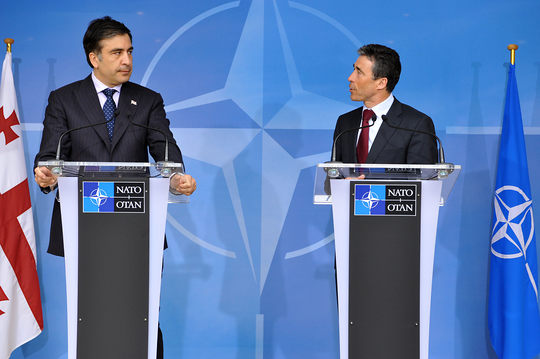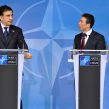
Georgia: The Ultimate Test of NATO’s Open Door Policy
Publication: Eurasia Daily Monitor Volume: 9 Issue: 103
By:

NATO’s Open Door Policy is as old as the Alliance itself, and remains to date a core principle of the Alliance. Under NATO’s founding treaty, the “Allies may, by unanimous agreement, invite any other European state in a position to further the principles of this Treaty and to contribute to the security of the North Atlantic area, to accede to this Treaty. Any State so invited may become a Party to this Treaty” (Article 10, North Atlantic Treaty, Washington, April 4, 1949).
The Alliance went on to accept Greece and Turkey (1953), West Germany (1955) and Spain (1982) as NATO members. In time, NATO established criteria and standards to be met by countries aspiring to join the Alliance. It also developed mechanisms to assist aspirant countries to qualify for membership.
The Membership Action Plan (MAP), introduced at NATO’s 1999 summit, became the preeminent mechanism in that regard. Twelve former communist-ruled countries joined NATO in three consecutive enlargement rounds completed in 1999, 2004 and 2009, respectively. Many of them graduated to membership from their respective MAPs. All aspirant countries that did go through MAPs (some of them in multi-year cycles) ended up being invited to join the Alliance as full members.
Georgia, however, became the first-ever aspirant country to be denied a membership action plan. Germany vetoed it at NATO’s 2008 Bucharest summit, in deference to Russia and as part of Berlin’s neo-Ostpolitik policy. The German government maintained that Georgia could not qualify for the accession track to NATO as long as the conflicts with Russia in Abkhazia and South Ossetia remained unresolved.
This conditionality was a novel position for Berlin to take. Only one year previously, even the Russia-friendly Minister of Foreign Affairs Frank-Walter Steinmeier had argued that such conditionality would award Russia an indirect veto on NATO’s open door policy. Consequently, Berlin’s position incentivized Moscow to escalate those conflicts as a means to block Georgia’s path to NATO.
Berlin held up the re-consideration of a MAP for Georgia at NATO’s subsequent summits: Strassburg-Kehl in 2009, Lisbon in 2010 and Chicago in 2012, with Germany now leading a small group of mostly underperforming allies that stonewalled Georgia’s membership perspective (see EDM, May 29). Reflecting some deference to Russian interests and special bilateral relations with Moscow, the blockage cast two NATO principles into question: the open door to accession (MAP-assisted, in this case), and the immunity of allied decision-making processes to outside inputs (Russian ones, in this case). Thus, Georgia’s membership perspective became a test of the Alliance’s open-door policy and the integrity of its decision-making processes.
Assessed on its geostrategic value, Georgia is a top strategic prize for NATO and the West writ large. The country sits astride the sole existing direct access corridor between Europe and Asia. It guarantees free westbound movement for Caspian oil and gas to Europe, and free eastbound access for US and NATO forces to Asia. However, Georgia’s unique geostrategic value does not seem to figure in NATO’s debates over Georgia’s membership aspirations. NATO seems to behave like a post-modern, politically correct alliance when minimizing geostrategic criteria in its overall assessment of Georgia’s membership prospects.
Assessed on its performance, Georgia has delivered at least as much, and possibly more to NATO than any aspirant country in the pre-membership stage; and more indeed than many NATO member countries. Namely, Georgia has:
• offered unlimited air and overland passage and transit rights for NATO and US forces operating in Afghanistan from 2001 to date (these arrangements will undoubtedly continue serving residual NATO/US forces in Afghanistan post-2014);
• contributed some 2,500 troops to the coalition-of-the-willing in Iraq;
• promoted domestic public understanding of and support for NATO, resulting in overwhelming popular support for Georgian membership (77 percent in the January 2008 plebiscite and similar levels in current public opinion surveys);
• become the largest non-NATO troop contributor to NATO-led operations in Afghanistan, and second only to the US in troop contributions on a per capita basis (just under 1,000 at present, due imminently to increase to 1,700). Georgian troops operate mostly in the high-risk Helmand province, facing growing casualties, and not invoking “national caveats” (limitations that most NATO member countries invoke to reduce their own combat involvement).
Compared with NATO’s newest members Albania and Croatia (their membership action plans approved by NATO back in 2002, membership invitations in 2008, accession finalized in 2009), Georgia’s contributions are on a far higher order of magnitude. The difference is even starker between Georgia’s contributions and those NATO membership aspirants Macedonia, Montenegro and Bosnia-Herzegovina. Meanwhile, NATO assessed Macedonia as having fulfilled the membership criteria in 2008, and invited the country to join the Alliance (Greece has blocked Macedonia’s accession by demanding a change of the country’s name). NATO approved membership action plans for Montenegro and Bosnia-Herzegovina in 2009 and 2010, respectively, contending with internal political hurdles in the two countries.
Against this backdrop, the stonewalling of Georgia by a small group in NATO looks increasingly hard to defend or justify. The German-led group puts the entire Alliance in the bizarre position of keeping out a high-value, top-performing contributor to NATO. This situation stems largely from considerations relating to a third party, Russia, outside NATO. The Alliance’s door is open, but hurdles are placed selectively in Georgia’s path to that door by this group in NATO. This group has turned the issue of Georgia’s membership prospects into the ultimate test of NATO’s Open Door Policy and its internal decision-making processes. It is a test that NATO can no longer shun without damage to its credibility.




